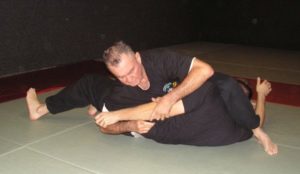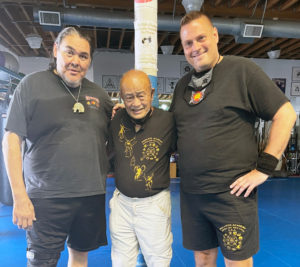
Grappling was the last of the combative ranges in Jeet Kune Do to be developed by Sijo Bruce and the development. It was cut short by his untimely death and has been left to the next generations of JKD practitioners to develop on their own. Notables who have explored and developed the grappling range are Guro Dan Inosanto, the late Sifu Larry Hartsell, and CSW founder Coach Erik Paulson. Sijo Bruce had been experimenting with throws, takedowns, and locks out of a kickboxing to trapping to grappling paradigm and had several sets when he passed away. The grappling consisted of movements and techniques from Chin Na, Judo, Wresting, and Ju Jitsu at that time period. In their practice, according to Guro Dan Inosanto, they never contested the lock or do what we would call “rolling” today.

Sifu Larry Hartsell turning someone into a pretzel.
As Guro Inosanto and Sifu Hartsell developed the grappling range more during the 1970’s and 1980’s they incorporated southeast Asian grappling arts such as Dumog and Silat into the JKD Grappling. They also became exposed to the arts of Shooto through Sensei Yori Nakamura, Brazilian Jiu Jitsu with the Machado Brothers, Catch Wrestling, and Sambo and began to incorporate them as well. With Shooto and Brazilian Jiu Jitsu, the concept of contesting the lock and countering the ground techniques (rolling) became common practice. Today you will see different JKD practitioners study Brazilian Jiu Jitsu, Judo, Wrestling, Catch Wrestling, Shooto, CSW, and other grappling arts as ways to inform their grappling range. With the JKD community getting heavily into grappling, they have also become aware of the debate of training gi vs no gi. This is a legitimate concern to JKD practitioners who are seeking out combat effectiveness for self defense.
Common practice of JKD schools generally is not to train in gis or any traditional outfits because there is no belt or sash ranking systems and JKD looks to be . There is not any main stream JKD organization that has a sanctioned belt system for the organization though several allow individual schools to implement any ranking system within their schools including belts, sashes, etc. Keeping the no belt tradition in a non traditional martial art is something a JKD Grappling practitioner may consider when training grappling. They may very well put on a gi for a Brazilian Jiu Jitsu class or a Judo class but stay away from it when potentially mixing grappling systems in a class or doing more of an MMA style class. I’m not new to grappling in general but am a new practitioner of Brazilian Jiu Jitsu and in my practice I found, pretty quickly, the gi vs no gi debate in the Jiu Jitsu world. Since I stand in an interesting place of having quite a bit of experience in grappling but being a relative newbie to BJJ I asked the opinions of three grappling luminaries, Professor Gary Padilla (BJJ Instructor at the Inosanto Academy of Martial Arts and BJJ advisor to the Jun Fan Jeet Kune Do Grappling Association, BJJ Black Belt under Professor Jean Jacques Machado), Coach Kenny Johnson (wrestling champion from the University of Iowa/Dan Gable program, founder of Bolt Wrestling, MMA wrestling coach, and BJJ Black Belt under Ruebens “Cobrinha” Charles) and Coach Erik Paulson (MMA coach, Founder of CSW, former Shooto and MMA champion, BJJ Black Belt under Professor Rigan Machado) to add to my own.

Atticus Todd, Guro Dan Inosanto and Sifu Tim Becherer
My first BJJ instructor, Professor Sean Choi trained me exclusively no Gi because of my JKD background. He wanted me to start here so as not to rely on the gi for set ups, locks, chokes, etc. I think this is a fine mentality to have and one should know technique that does not rely on a gi but ignoring gi training altogether only gives you a partial picture of fighting (whether it be ground or standing) for self defense. For the most part, if you get in a physical altercation with someone outside of a spa, they and you will most likely be wearing clothing. Depending on the climate, it could be just a little bit more than a typical rash guard and shorts all the way to parkas, thick pants, and boots…quite a bit more than the average BJJ Gi. Learning to manipulate clothing is important in real life and death combat. You want to be clear on how to use the clothing to your advantage, what your disadvantages are, and how your opponent may use that clothing against you. I gained a good clinch game somewhat early in my JKD training with my instructors Sifu Larry Hartsell and Sifu Atticus Todd (a former collegiate wrestler from Minnesota). One of the first things I noticed when putting on a gi and rolling in. BJJ is how muddled my arm drags and other upper body manipulations became when the opponent could grab your uniform. This was a nice dose of realism outside of the game we played when just in t-shirts and concentrating more on the methods of wrestling, boxing, Wing Chun, and Panantukan.
In my discussions with Professor Gary Padilla, he emphasized that the entanglements of the gi start to make your technique very clean as you’re dealing with a different type of grip on the cloth. It just simply makes certain things harder. As you get used to dealing with the harder technique, the easier becomes easier. Professor Gary also, for self defense, likes the understanding of the use of clothing to choke and manipulate limbs. He considers it essential for self defense training.
When I spoke with Coach Kenny Johnson, I was looking for the perspective of someone who has spent the vast majority of their grappling without a gi. What I really like about Kenny and the way he teaches and trains is his understanding on how wrestling works into both a sport martial art paradigm and a self defense martial art paradigm. Coach Kenny’s observation is that for competition, gi and no gi are almost two separate arts. For self defense he sees the gi as a necessary item to train with. Much like Professor Gary, Coach Kenny sees the manipulation of clothing as an essential education for self defense as the use of the clothing by combatants is a real tool or obstacle to deal with.
For experienced thoughts on grappling for any level of combat, few can match the experience of CSW Coach Erik Paulson. Coach Paulson also is in favor of gi training for self defense. He believes that it teaches you how to manipulate clothing to off balance people, how to do takedowns using different handles, and how to apply a quick collar choke. Building the attribute of manipulating clothing to enhance your abilities to off balance, takedown, throw, and choke any attacker can give you the ability to end a confrontation quickly which is what you’re looking for in self defense. The longer you have to fight, the more danger you could possibly be in.
Even though the gi is not like every day clothing, it is good to use it for the bulk of your clothing training. It is durable and resistant to the constant pulling and grabbing that is part of regular repetition training. If regular t-shirts and pants that people wear are used, they would rip, tear and shred quite often and you would be replacing them which is quite a dent in the pocketbook. That being said, the materials of regular clothing being weaker, it is good to train in and use regular clothing every once in awhile so you can see what gi maneuvers are a little less effective with thinner cloth. You may find that certain cloths have more flexibility and make getting a good choke on the opponent more difficult if not impossible. However, if a good choke can’t be executed, you usually still have great control of the head with the cloth and can still manipulate the body.

In my time with Sifu Hartsell, we didn’t talk about this topic specifically so I can only offer a guess on his thoughts. Sifu Larry was definitely about getting to the practical side of the fighting aspect of the martial arts. In my time with him, we didn’t train in gis but I do remember he told me once that he was going off to train with the infamous Sensei Gene LeBell and Sensei Gokor Chivichyan and said “I’m putting on the white belt again big guy.” I also have Sifu’s gi from these sessions. Sifu Larry certainly didn’t shy away from training in the gi and he had no complaints that he voiced to me. What I can see is Sifu Larry coming up with countless ways to use the clothing as a weapon and lever.
When gi training for JKD grappling, striking needs to be added. You want to see how that changes the techniques preferred and how it sets up submissions. Test how to use the clothing to defend the strikes and even impair the opponent for your strikes. Essentially, learn how to fight dirty using the clothing. Think about the types of clothing worn in your area and during different seasons. Test rolling and sparring in those clothes.
For JKD grappling in the Jun Fan Jeet Kune Do Grappling Association, we find the clothing to be a vital part of combative grappling for self defense. With this in mind, the Gi is an important part of training. I fully recommend that anyone adding grappling to their personal system take up a practice of BJJ as well as other grappling arts. I also fully recommend that at times in rolling, step outside of the rules of sport BJJ and add in the striking and manipulation of clothing therein. Experiment with different types of clothes and even accessories such as bags, satchels, scarves, etc and see how they fit into your combative methods. Think outside of the box. Most of all, have fun with your training.
